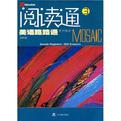美语路路通
出版时间:2005-1 出版社:辽宁万有出版社 作者:(美 页数:246
内容概要
《阅读通3》讲述了:Multiple-Choice Questions An important rule to remember when answering multiple-choice questions is to read the answers first. This way, youll view each answer separately and equally, without “jumping” on the first and easiest one. Look for an answer that not only seems right on its own but completes the question smoothly. If the question asks why something occurs, then your answer must be a cause. Try to eliminate any obviously poor answers. Suspect as a possible right answer phrases such as “all of the above,” “none of the above,” or “two of the above.” Check the wording of questions to notice qualifying phrases such as “all of the following are true ex- cept...” or “which two of the below are not...”。
书籍目录
New Challenges Page 12 Looking at Learning Page 193 Relationships Page 394 Health and Leisure Page 535 High Tech, Low Tech Page 736 Money Matters Page 897 Remarkable Individuals Page 1079 Human Behavior Page 14910 Crime and Punishment Page 17111 The Physicai World Page 19312 Together on a Small Planet Page 213
章节摘录
Objective tests are those that include questions in a true/false, multiple-choice, matching, or fill-in format. Usually the answer is provided but the student must de- cide among several possibilities. 1. True/False Questions True/false questions are the easiest test questions for the obvious reason that you have at least a fifty-fifty chance of getting the right answer. First, be sure you have read the question correctly. Look for words such as always or never, these words often indicate a false answer. Words such as often, usually, rarely, or sometimes can indicate a true answer. Decide if the statement is totally true before you mark it true. Answer what the tester intended, not what you read into the question. For example, the statement "General Motors produces compact cars" is true. If the question had read "General Motors alone produces compact cars," then it would be false. On true/false questions, stick with your first impression. Studies have shown over and over that your first impression is usually right, so be slow to change your answer, if you change it at all. A statement is more likely to be true if it is a fairly long statement; it takes more qualifiers to make a true statement than a false one. 2. Multiple-Choice Questions An important rule to remember when answering multiple-choice questions is to read the answers first. This way, youll view each answer separately and equally, without "jumping" on the first and easiest one. Look for an answer that not only seems right on its own but completes the question smoothly. If the question asks why something occurs, then your answer must be a cause. Try to eliminate any obviously poor answers. Suspect as a possible right answer phrases such as "all of the above," "none of the above," or "two of the above." Check the wording of questions to notice qualifying phrases such as "all of the following are true ex- cept..." or "which two of the below are not..." Statistically, the least likely correct answer on a multiple-choice question is the first choice. When in doubt, pick the longer of two answers. But, just as in true/false sections, always put something down. Even an educated guess is better than leaving the question blank and get- ting it wrong for sure. 3. Sentence Completion or Fill-In Questions These generally ask for an exact word from memory. They dont allow for much error, so make sure your answer is a Ioqical part of the sentence as a whole。
图书封面
评论、评分、阅读与下载
用户评论 (总计0条)
相关图书
- 阅读通4(第4版)
- 写作通1
- 写作通3
- 美语路路通系列教材-写作通4(第四版) (平装)
- 一位高三学生父亲的日记
- 语文 五年级 上册
- 新课标《单元测评卷》语文 四年级 上与人教版义务教育课程标准实验教科书同步
- 新课标《单元测评卷》数学 四年级 上与人教版义务教育课程标准实验教科书同步
- 《新课标单元测评卷》数学 五年级上 与人教版义务教育课程标准实验教科书同步
- 日语词汇学教程
- 看世界(第4辑)
- 胡萝卜须
- 两年高考真题全解。语文
- 常备高中公式定理词典
- 两年高考真题全解。文科综合
- 两年高考真题全解。理科综合
- 小学数学培优辅导教程。三年级
- 小学数学培优辅导教程。四年级
- 小学数学培优辅导教程。五年级
- 小学数学培优辅导教程。六年级
- 红魔中考英语绿卡·考纲词汇
- 美语路路通(3)听说通:磁带6盘(第四版)
- 美语路路通(入门篇)阅读通(磁带1盘)新版
- 美语路路通
- 美语路路通(2)阅读通:磁带3盘(第四版)
